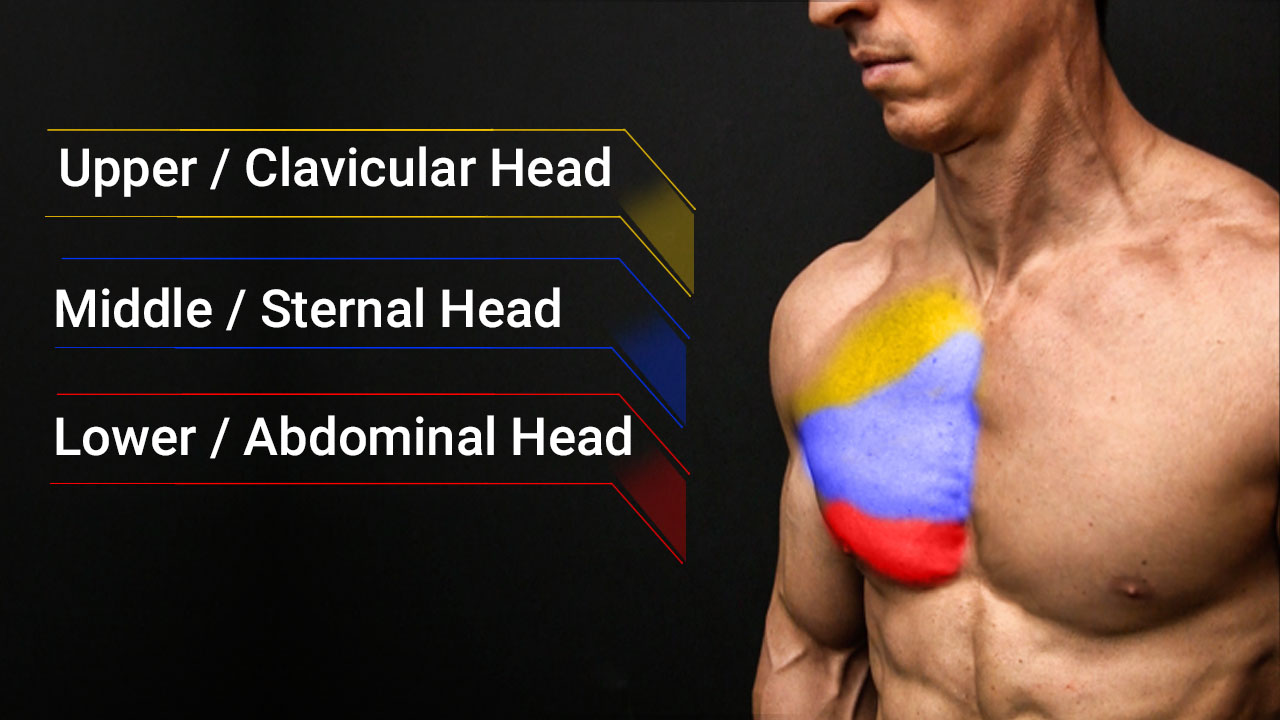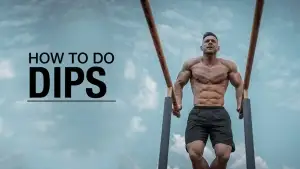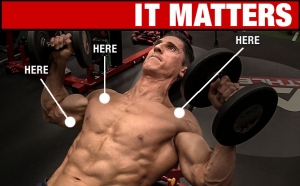
UPPER PECS & LOWER PECS EXERCISE CHEAT
I’m going to show you a simple chest day hack you can use during any chest workout that will help you build more chest muscle mass.
You might think of the pec muscle as one large muscle. Technically speaking it is. It’s a single fan-shaped muscle that originates along a wide area of the chest wall, from the collar bone all the way down to the top of the abdominals.
In all, there are three distinct muscle origins of the pectoralis major, and these define the three divisions of the chest muscles. Work all three and you’ll develop the entire chest.
The pec major inserts on the upper arm bone and–spoiler alert–the direction your upper arm travels during chest exercises directly influences which region of the pec gets the emphasis during resistance exercise.
The pectoral muscles have direct influence on the function and health of the shoulders, because they empower rotation of the shoulder joint in the sagittal plane of motion. Healthy, strong pecs help prevent shoulder injuries.
CHEST ANATOMY
I’ve outlined the three regions of the pec major muscle here using my Muscle Markers, which helps us get a handle on the pec muscle’s design.
The black marker pen highlights the clavicular head where the pec major originates along the collar bone. This is the upper pec region.
UPPER PECS (CLAVICULAR HEAD)

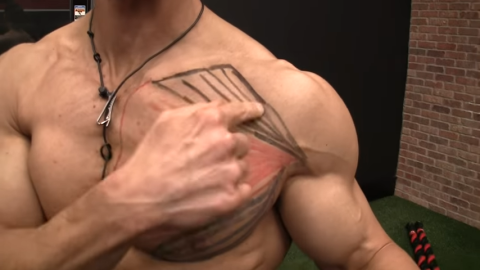
In red, the middle pec or sternal head originates at the sternum and is responsible for horizontal adduction of the shoulder joint.
MIDDLE PECS (STERNAL HEAD)

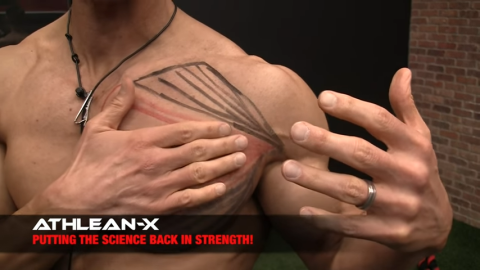
In blue is the lower pec or abdominal head that originates on the upper abdominal area at the rib cage.
The obliques also attach to the same area of the rib cage.
Working your lower chest as well as your obliques will help create that chiseled look we all want.
LOWER PECS (ABDOMINAL HEAD)

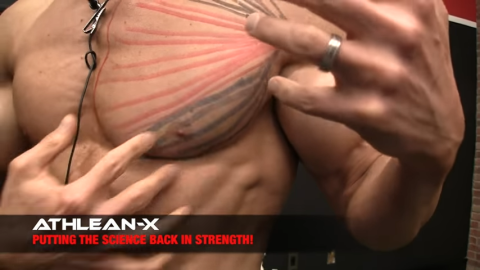
The trick is to know which exercise variations favor each of the three areas of the pectoralis major. I’m often asked how to target these three different divisions of the chest.
Let’s look at some common chest exercises and how you can determine which part of the chest gets favored by a given movement, starting with two variations of the dumbbell bench press and using an adjustable bench.
DECLINE BENCH FAVORS LOWER CHEST
If I were to go to a decline bench with a pair of dumbbells, I can target the lower chest.
Although this exercise activates the entire pec, the decline position is one of the best ways to target the lower chest because the weights travel upward against gravity at a decline angle in relation to the chest muscles.
DECLINE BENCH PRESS (LOWER CHEST)

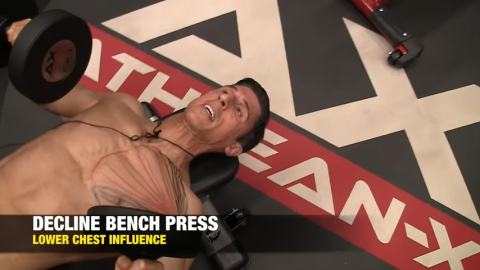
INCLINE BENCH FAVORS UPPER CHEST
If we use the incline position to work the upper chest, you can clearly see the pec muscle flexing along the collar bone because this favors the top portion of the chest.
Here’s the big reveal. It’s all about your arm position in relation to the pectoral muscle.
INCLINE BENCH PRESS (UPPER CHEST)

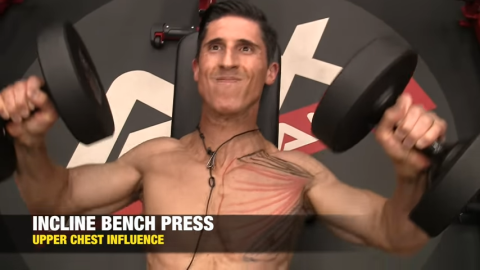
Let me demonstrate.
Sit up from an incline bench press and look where your arms are in relation to your upper body. They’ll be angled slightly upward if you have your adjustable bench set to the correct height, which means you’re hitting the upper pec.


Raising the arms higher will begin to work the shoulders. If you have the bench set to too steep an angle, you will favor the anterior deltoid instead of the pectorals.
Now let’s demonstrate using the decline bench. At first glance, you might think that the arms are straight out away from the upper body. But if you sit up, you’ll see that the arms are angled slightly downward from the upper body.

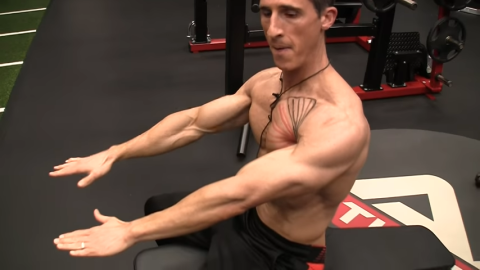
Your arms need to be beyond 90 degrees from perpendicular to your body to favor the lower pecs. They need to be less than 90 degrees, “above” the shoulders, to favor the clavicular head of the pecs.
I probably don’t need to say that if we were using a flat bench, the arms would be extended straight out. A flat bench will favor the bulkier middle portion of the pec major.
You can’t isolate one portion of a single muscle like the pec. You can only favor certain regions of the muscle or work the muscle in a more biomechanically accurate way by how you line up the line of force with the direction of resistance.
INCLINE AND DECLINE PUSHUPS: OPPOSITE MECHANICS FROM BENCH PRESS
It can get a little confusing if you compare incline and decline pushups to incline and decline bench press.
In the case of incline push-ups and decline push-ups, the angle of the arms is opposite what they are for incline and decline bench.
When you perform an incline push-up, the body is indeed at an incline, but the arms are oriented downward in that incline push-up position, making the incline push-up like the decline bench press.
INCLINE PUSHUPS (LOWER CHEST)


The reverse holds true for decline push-ups, where the arms are oriented like they would be on an incline bench press. In the decline push-up position, the arms are actually “above” the shoulders because they’re in line with your head.
DECLINE PUSHUPS (UPPER CHEST)


Your body is angled down because your feet are higher than your shoulders and head in relation to the floor, but your arms are “higher” than your shoulders in relation to your body.
Your arms would be at more-or-less 90 degrees–straight out–from your upper body in a regular push-up.
Next, let’s look at three other common chest exercises and how arm position shifts the load to different regions of the pec major.
CABLE CROSSOVER (CABLE FLY) ARM POSITION RULES
The really cool thing about the cable crossover machine is that you can tune which chest area gets the focus by how you position your upper body relative to the cables.
In the High-to-Low Cable Crossover (or Cable Fly) the starting position is above the shoulders at head level and the finishing position is down near hip level. The downward angle arm direction of the high-to-low cable crossover favors the lower portion of the pec major muscle.
HIGH-TO-LOW CABLE CROSSOVER (LOWER PECS)

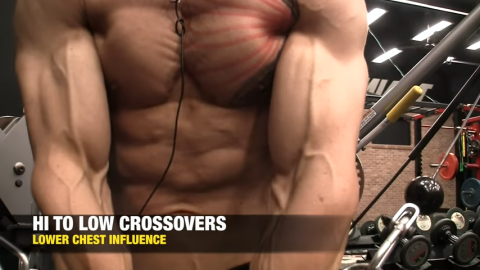
In the High-to-Low Cable Crossover (or Cable Fly) the starting position is above the shoulders at head level and the finishing position is down near hip level. The downward angle arm direction of the high-to-low cable crossover favors the lower portion of the pec major muscle.
LOW-TO-HIGH CABLE CROSSOVER (UPPER PECS)

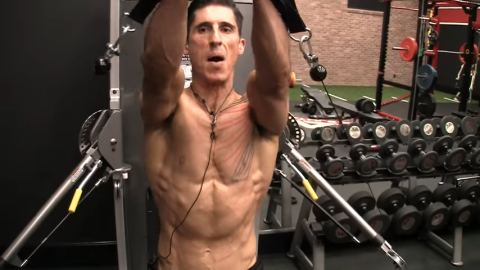
You can target the upper chest muscles by lowering the cables and doing a Low-To-High cable crossover where the arms’ starting position is below your waist and their finishing position is above the collar bones.
The high finishing arm position above shoulder height is similar to the incline bench press, so you’re hitting the upper chest again.
Anytime your arms finish in a perpendicular relationship to your upper body, this would be hitting middle pecs.
A double cable pulley machine works best for the cable crossover (or cable fly).
CABLE CROSSOVER OR CABLE MACHINE FLY: IMPORTANCE FOR CHEST MUSCLE GROWTH
Are cable crossovers and cable flyes the same exercise? Not quite.
The biggest difference between a cable crossover and cable fly is the end point of the exercise. The crossover is going to feature a crossing of midline with the hands reaching as far across the chest as possible (with either the left hand over the right or right over left).
In the cable fly, the hands are going to meet at midline and no further, at the end of each rep. However, they are both “adduction” focused chest exercises, so the benefits are similar.
What makes this movement so beneficial?
The cable crossover (or cable fly) is maybe the most versatile chest exercise you can do. With the cable machine, you can do an entire chest workout if you like.
As described above, the cable crossover or cable fly can be used to train all three heads of the pectoralis major: the clavicular head and the sternal head and the abdominal head.
However, the cable fly is maybe one of the most butchered chest exercises there is because of the cable machine setup.
Simply position your upper body with the pulleys to achieve the direction of arm pull you need. You do not need to walk the cables halfway across the floor to perform a proper cable fly. A small step forward is all you need.
Keep in mind though that a cable fly or a cable crossover is not a core exercise although you do need to maintain core stability. Standing too far away from the cable crossover machine makes keeping your body stationary much more challenging.
If you want to train the lower pecs, stand directly under the pulleys and move your arms downward. And the same idea holds true for training the clavicular head (upper pec). Position the pulleys down by your feet and pull upward. Anytime you are moving with the arms perpendicular to the chest, you would be working the mid chest.
A staggered stance works well for this exercise. Maintain a slight bend in your arms to avoid overloading the biceps tendons in a stretched position and remember to keep your core tight.
OTHER EXERCISES TO HIT UPPER AND LOWER PECS
Let’s wrap up with a couple more of my favorite exercises to hit upper and lower chest.
You’ll see that these follow the same arm positioning rules as the rest of the exercises we’ve already talked about.
PULLOVER (UPPER PECS)

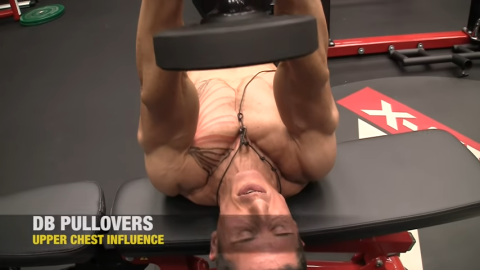
Squeeze your elbows in, toward each other so that your biceps squeeze toward each other. Don’t flare your elbows out. The arm position shows that this exercise hits upper chest.
CHEST DIPS (LOWER PECS)

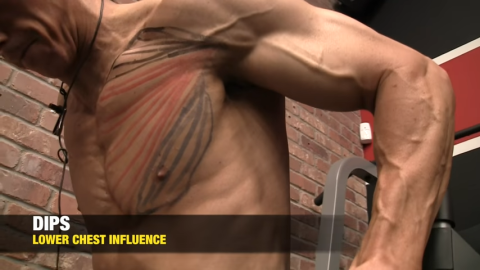
The dip positions the arms in an extreme downward orientation in relation to the upper body. They’re in that position we’ve associated with lower pec involvement.
Here at the dip station, you can see the extra stretch of the lower pec area at the end range of motion; it’s highlighted with the dark blue marker lines.
No matter which muscle it is you’re trying to target; the anatomy is going to show you how to target it. Follow the fibers for clues into how a movement might favor a muscle.
Remember that regardless of the exercise or body part, the direction of the fibers, the alignment of the muscle origin and insertions, biomechanical levers, and the direction of resistance dictates whether the muscle will be worked efficiently or not.
If you’re looking for a training program that leaves no muscle or area behind, you’ve come to the right place. Check out our ATHLEAN-X programs to see which is the best fit for your goals and fitness level.

- The chest muscles (the pectoralis major muscles) are single, fan-shaped muscles that have three segments that originate in three locations along the bones of the chest.
- The upper pec area originates along the clavicle. The middle, meatiest area of the pecs originates along the sternum, and the lower pec fibers originate along the rib cage where the oblique abdominal muscles also attach.
- You can target the region of the chest you want to focus on by either selecting an exercise that favors that region, or, by fine-tuning your arm position relative to your chest.
- Exercises where the arms finish “low” will involve the lower pec region. Exercises where arms finish above the collar bones will favor the upper pecs. Exercises where the arms finish “out in front”, perpendicular to your upper body, will favor the middle chest fibers.
- Exercise names can be confusing. Movements like incline and decline push-ups work the opposite of the decline or incline bench, because the arms finish in different positions.
- You can apply this knowledge about the influence of arm position to all your chest training. Use of proper form always applies.

Jeff Cavaliere M.S.P.T, CSCS
Jeff Cavaliere is a Physical Therapist, Strength Coach and creator of the ATHLEAN-X Training Programs and ATHLEAN-Rx Supplements. He has a Masters in Physical Therapy (MSPT) and has worked as Head Physical Therapist for the New York Mets, as well as training many elite professional athletes in Major League Baseball, NFL, MMA and professional wrestling. His programs produce “next level” achievements in muscle size, strength and performance for professional athletes and anyone looking to build a muscular athletic physique.














